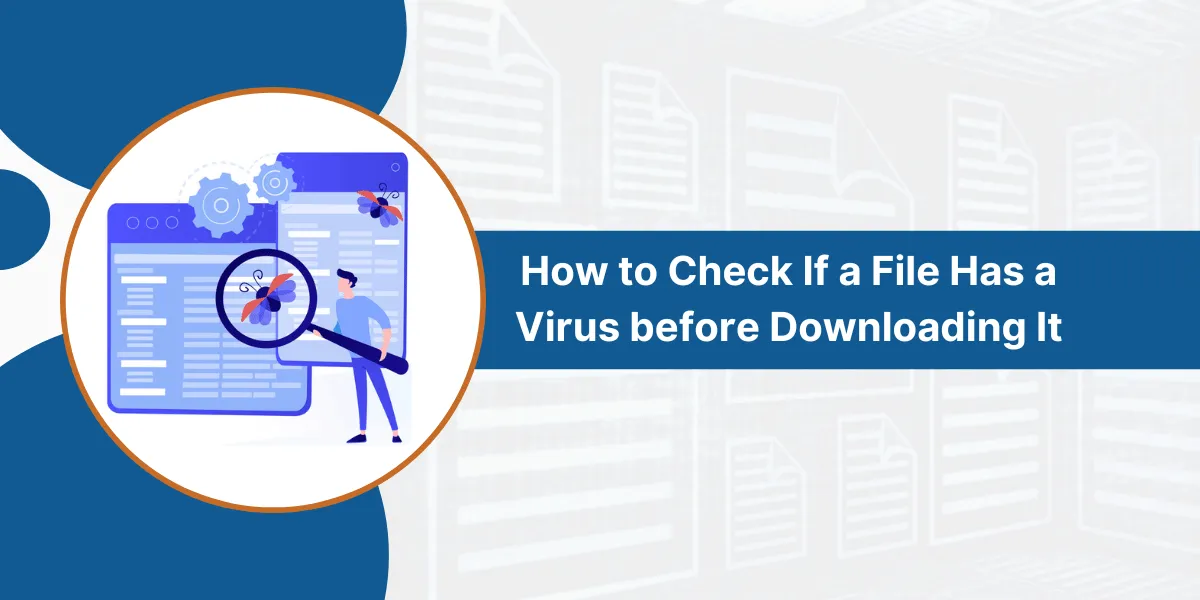How to Make Sure a File Is Safe Before Downloading It
Downloading files from the internet always carries some risk, as you never know for sure if a file contains a virus or other malware. However, there are steps you can take to check if a file is safe before downloading it to your computer. Being cautious and scanning files for viruses first can help you avoid infecting your device and losing important data.
Key Takeaways
- Viruses and malware can easily spread through file downloads. Always be cautious when downloading files from unknown or untrusted sources.
- You can check a file’s reputation online by searching for reviews and scanning it with online virus scanners before downloading.
- Know the source of the file and only download from trusted, reputable sites. Avoid pirated software and illegal file downloads.
- Check the file extension – unfamiliar or double extensions like .exe.zip can indicate a disguised virus file.
- Use built-in Windows tools like Windows Defender to scan files before opening them. Third-party antivirus software also helps detect viruses.
- Monitor file behavior after downloading. If your computer starts acting unusual, it may be due to a virus from a downloaded file.
Always Check the File Source and Reputation
The first step in determining if a file is safe to download is checking where it is coming from. Knowing the source of the file will give you important context on whether it can be trusted or not.
Here are some tips on assessing the file source:
- Only download files from official, reputable sites: Stick to downloading software, programs, and other files from the official company or developer websites when possible. Avoid unofficial third-party download sites, as they are more likely to contain malware.
- Research the site’s reputation: Before downloading, do a quick internet search to see if other users report issues or viruses from the site. Check reviews and complaints. Reputable sites will have overwhelmingly positive feedback.
- Beware of pirated or illegal content: Downloading cracked software, movies, music, and other copyrighted files from peer-to-peer sites or torrents is very risky, as they frequently contain viruses disguised as legitimate downloads. Avoid these sites entirely.
- Check the URL for inconsistencies: Phishing sites imitate real websites, but the URL will be slightly different. Verify you are on the correct domain before downloading.
- Avoid ads, pop-ups, or enticing download offers: Sketchy sites will try to get you to download files through manipulative ads or appealing free offers. Don’t fall for these tricks that likely harbor malware.
Look at the File Extension
One easy way to determine whether a file may contain a virus is to look at the file extension at the end of the file name.
The file extension indicates what type of file it is, and unusual or misleading extensions can be a red flag for malware.
Here are some tips for inspecting a file’s extension:
- Know common media and document extensions: .DOC, .PDF, .MP3, .MP4, .JPG, .PNG are some normal file extensions. Anything unfamiliar could be suspicious.
- Watch for double extensions. Sometimes, viruses hide under two extensions, like filename.jpg.exe. Anything with .exe should be scanned.
- Question generic or missing extensions: Files ending in .tmp, .app, or no extension at all are ambiguous and could hide harmful code.
- Avoid .exe files from unknown sources: While some .exe files are legitimate programs, executables can also contain dangerous viruses. Only download .exes from official developer sites.
- Check compressed files like .zip closely: Malware is commonly hidden in compressed archives. Carefully scan the compressed folder before extracting any files.
Always Scan the File with Antivirus Software
Antivirus software is designed to detect viruses, malware, and other security threats within files. Scanning a downloaded file with antivirus software before opening it is one of the best ways to determine whether it’s safe.
Here are tips for scanning with antivirus tools:
- Use Windows’ built-in protections. Windows 10 and 11 come with Windows Defender Security Center, which can scan downloaded files or external drives for threats before accessing them.
- Install trusted antivirus apps: Programs like Malwarebytes, AVG, Avast, and Norton provide real-time scanning that can automatically detect virus-ridden downloads.
- Configure auto scan settings: Most antivirus programs allow you to customize scans to run automatically whenever you download files or access external drives. Enable these for convenience.
- Manually scan files and folders: If auto-scan is disabled, manually trigger a scan by right-clicking files or folders and selecting “Scan with antivirus” to check for threats.
- Schedule regular in-depth scans: Set your antivirus to run comprehensive full system scans every week or so to detect hidden malware anywhere on your device.
- Quarantine or delete detected threats: If a scan finds a virus, follow antivirus prompts to isolate the file in quarantine or delete it completely. Never open confirmed virus-containing files.
Use Online Virus Scanning Tools
If you don’t have antivirus software installed or want an additional safety check, you can scan downloaded files through free online virus scanners before opening:
- VirusTotal: This website lets you upload file downloads and scan them through over 70 different antivirus engines to provide a safety report.
- MetaDefender: This program works similarly to VirusTotal, scanning your file across several antivirus platforms. It also safely isolates threats.
- Jotti: Another online multi-engine scanner that verifies a file against dozens of antivirus databases. Easy upload and scanning.
- Hybrid Analysis: Specialized for scanning Windows executable files for malware by running them in a sandbox first.
- ImmuniWeb provides not just malware scanning but also broader cybersecurity testing for software vulnerabilities.
9 Best Ways to Avoid Downloading Viruses and Other Malware
- Use antivirus software
- Only download from trusted sources
- Watch out for phishing scams
- Keep software updated
- Use ad blockers
- Practice safe browsing habits
- Sign Software/Application Code with Code Signing Certificate
- Don’t Ignore Windows Defender SmartScreen Warnings
- Always Read User Reviews to See that What Others Say
1. Use antivirus software
Antivirus software can detect and remove malware from your computer. Make sure to keep your antivirus program up to date, perform regular system scans, and schedule automatic scans. Many antivirus programs also have real-time protection to catch malware before it can infect your system. Using robust antivirus software is one of the best ways to avoid malware.
2. Only download from trusted sources
You’re much more likely to encounter malware from questionable websites and links. Stick to official app stores like the Google Play Store and Apple App Store for mobile apps. For desktop software, only download from the official company websites. Avoid torrent sites and other sources where malware is common.
3. Watch out for phishing scams
Phishing emails and websites pretend to be legitimate to trick you into entering passwords or downloading malware. Verify the sender’s details using an email lookup tool. Don’t click links or attachments in unsolicited emails. Carefully examine URLs for misspellings or unusual domains. Avoid entering sensitive information into suspicious sites.
4. Keep software updated
Malware often exploits security flaws in outdated software. Enable automatic updates on your devices and software so you always have the latest security patches. Update your operating system, browser, apps, plugins, and other programs regularly. Updates fix vulnerabilities that malware could use to infect your system.
5. Use ad blockers
Online ads can sometimes be compromised to distribute malware. Using an ad blocker prevents malicious ads from loading. Popular ad blocker extensions are available for browsers like Chrome and Firefox. This removes a potential malware vector.
6. Practice safe browsing habits
Dangerous websites are another malware source. Don’t visit questionable websites or click risky ads and popups. Stick to well-known, legitimate sites as much as possible. Be cautious with downloads and don’t pirate copyrighted material. Safe browsing habits reduce malware exposure.
7. Sign Software/Application Code with Code Signing Certificate
A Code Signing Certificate helps verify that software comes from a trusted source and has not been altered or corrupted. Developers digitally sign their software with a code signing certificate from a trusted certificate authority. This adds a digital signature that operating systems and antivirus software can validate to confirm the software’s authenticity and integrity. If the code has been changed or the signature doesn’t match, the OS will block installation or generate a warning. Requiring valid code signing certificates for all software would significantly reduce malware infections from downloads since malware distributors usually don’t have proper code signing certificates.
8. Don’t Ignore Windows Defender SmartScreen Warnings
Windows Defender SmartScreen will show warnings if you try to download or run unrecognized or potentially malicious programs. It checks files against a Microsoft database of reported malware and suspicious sites. Heed these warnings and avoid proceeding. SmartScreen helps detect untrustworthy downloads before they can infect your computer. If you ignore the warnings, you’re much more likely to end up with malware on your system.
9. Always Read User Reviews to See that What Others Say
Before downloading software, take a look at user reviews. This gives you a sense of the software’s reputation and whether other users have reported malware or other problems. Look for apps with an overall high rating and a large number of reviews. Avoid apps with many negative reviews mentioning viruses, scams, or other sketchy behavior. User reviews can help tip you off to problematic apps to steer clear of.
How to Monitor File Behavior after Downloading
Even if you take precautions by scanning a file beforehand, some sophisticated viruses can still slip through undetected. That’s why it’s important to remain vigilant and monitor how both the downloaded file and your computer behave after installation.
Watch for these warning signs of a potential virus:
- Unusual activity from an installed application is high data usage, crashing, or freezing.
- Unknown processes running in the background are detected through Task Manager.
- New shortcuts, apps, or files appear without you installing anything.
- Changes to browser settings like new toolbars or homepage.
- Decreased device performance like slowdowns, lagging, or lack of storage space.
- Antivirus alerts about detected threats, even after an initial scan.
- Pop-ups, ads, or notifications you didn’t sign up for.
If you notice any of these issues arising shortly after installing a new file, it likely means your system was infected. Quickly run a virus scan and delete the problem file before the damage spreads further. Being alert to post-download issues can help halt a virus in its tracks.
Final Thoughts
Downloading new files always carries some inherent security risks. However, there are proactive steps you can take to evaluate downloads first before allowing them onto your system. Check the source, scan using both built-in and online antivirus tools, inspect the file extensions, and monitor your computer carefully after opening new files.
Paying attention to warning signs and using anti-malware defenses will go a long way towards keeping viruses off your device and data safe. Be vigilant, and avoid taking unnecessary risks that could compromise your computer’s security through malware-ridden downloads.
Frequently Asked Questions
What is the safest way to download files?
The safest way to download files is directly from official developer or company websites, not third-party sites. Also, be sure to scan anything from unknown sources with antivirus software before opening it.
Can you get a virus from visiting a website?
Yes, viruses can infect your computer simply by visiting compromised sites. Drive-by downloads and exploits target browser vulnerabilities to run malicious code. Keep software updated and avoid suspicious sites.
Are Apple computers immune to viruses?
No, Macs can still get targeted by viruses and malware, just less often than Windows PCs. Always exercise caution with downloads, avoid pirated software, and use antivirus protection.
Can a factory reset remove a virus?
If done correctly, factory resetting your device can remove viruses and malware. Be sure to back up data first, choose a full device wipe, and avoid reinstalling infected files from the backup afterward.
Does Windows Defender completely protect against viruses?
Windows Defender provides basic real-time protection but more limited detection rates than third-party antivirus software. For maximum safety, use Defender along with additional layered defenses.
How do I check if my phone has a virus?
On smartphones, warning signs of a virus include unexpected pop-ups, battery or data drain, sluggish performance, overheating, and strange app behavior. Install a trusted mobile antivirus app to scan for and remove threats.

Priya Mervana
 Verified Web Security Experts
Verified Web Security Experts
Priya Mervana is working at SSLInsights.com as a web security expert with over 10 years of experience writing about encryption, SSL certificates, and online privacy. She aims to make complex security topics easily understandable for everyday internet users.



